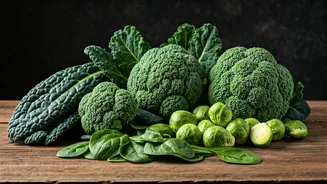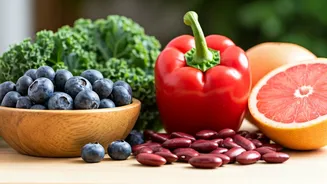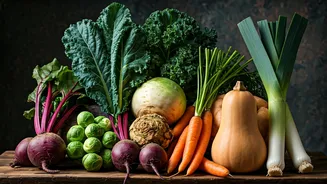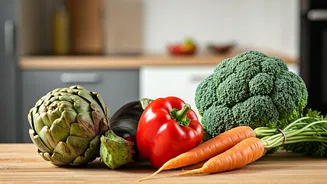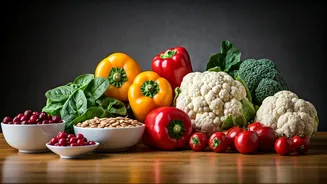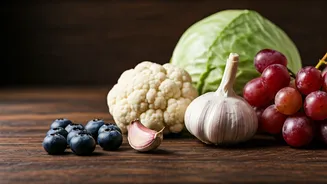Root Vegetables' Warmth
Root vegetables form the foundation of hearty winter meals, providing both substance and warmth. Carrots, for example, are a powerhouse of Vitamin A, crucial
for vision and immune function, and they are packed with fiber, too. Similarly, beets offer a unique sweetness and are a source of iron, contributing to energy levels and healthy blood. Potatoes, a staple in many cuisines, are a good source of Vitamin C and potassium, though it is best to be mindful of preparation methods. The beauty of these vegetables lies in their versatility. They can be roasted, mashed, or incorporated into soups and stews, making them easy to include in any diet. Their natural sweetness makes them appealing, especially when roasted to caramelize and bring out their flavors. Moreover, these vegetables are relatively inexpensive and widely available during the winter months, making them a practical and nutritious choice.
Leafy Greens' Vitality
Leafy greens provide a wealth of vitamins and minerals. Spinach is a well-known source of iron, which is essential for transporting oxygen through the body and maintaining energy levels. Kale, often hailed as a superfood, contains Vitamin K, essential for blood clotting and bone health, as well as a rich source of antioxidants. Mustard greens add a peppery flavor and are rich in Vitamin C, strengthening the immune system. Preparing these greens is simple and flexible. They can be added to salads, sautéed as side dishes, or blended into smoothies. They can also be incorporated into stews or soups. Their slightly bitter taste can be balanced with a touch of sweetness or a squeeze of lemon. These leafy greens are relatively low in calories and high in nutrients, making them a great choice for those aiming for a balanced diet.
Brassicas' Benefits
The brassica family, encompassing vegetables like cabbage, cauliflower, and Brussels sprouts, offers remarkable health benefits. Cabbage comes in various forms like green and red, all of which contain Vitamin C and fiber, which helps promote digestion. Cauliflower is incredibly versatile, and it can be used in numerous dishes, from mashed alternatives to pizza crusts. It is also packed with nutrients like Vitamin C and folate. Brussels sprouts, often overlooked, are a source of Vitamin K and antioxidants, and are especially delicious when roasted or slightly caramelized. Brassicas are known for their cancer-fighting properties, making them a must for a health-conscious diet. Cooking methods can alter their flavors, so steaming or roasting can mellow their natural bitterness. These winter vegetables offer a diverse range of flavors and textures, making them easily adaptable to a wide variety of meals.
Onions and Garlic
Onions and garlic are crucial ingredients for adding flavor to meals while providing various health benefits. Onions, a versatile ingredient, contain Vitamin C, as well as antioxidants which contribute to improved immunity and overall health. Garlic, with its potent flavor and aroma, is celebrated for its medicinal properties and is known to boost immunity and support heart health. Both ingredients enhance the flavor profile of any dish and are essential in numerous global cuisines. These ingredients are very easy to incorporate into any meal. They are staples in soups, stews, and stir-fries. They can be used raw, cooked, or as a base for various sauces. They are an affordable, readily available option for enhancing the flavor of your cooking while improving your health.
Other Winter Wonders
Beyond the core vegetables, several other winter produce offer valuable nutrients and flavors. Winter squash, which includes butternut, acorn, and spaghetti squash, is rich in Vitamin A, which is essential for vision, immunity, and skin health. Leeks, a milder relative of onions and garlic, add a delicate flavor to soups and stews. They are a good source of Vitamin K and fiber. Turnips, with their slightly bitter taste, are a source of Vitamin C and can be roasted or mashed, making for an interesting side dish. These other winter wonders further diversify the range of options available. The wide variety ensures that winter meals are never boring, providing new flavors, textures, and health benefits. Each of these vegetables can easily be adapted into various dishes, making them a staple in your winter meals.
Culinary Applications
Incorporating these winter vegetables into your diet is remarkably easy due to their versatility in the kitchen. For root vegetables, roasting is a great method to enhance their natural sweetness and create a depth of flavor. Leafy greens can be added raw to salads or lightly sautéed with garlic and olive oil. Brassicas can be roasted, steamed, or stir-fried. Onions and garlic can form the aromatic base for many dishes, sautéing them to release their flavors. Winter squash can be roasted, pureed, or added to soups. Experimenting with various cooking techniques allows you to find your preferred methods. Mixing and matching different vegetables and flavors makes for a complete and wholesome meal. Utilizing these vegetables will not only boost your health, but it will also enhance your culinary skills.
Nutritional Advantages
The nutritional advantages of winter vegetables extend beyond basic vitamins and minerals. They are naturally high in fiber, aiding digestion and promoting satiety. Fiber also helps regulate blood sugar levels, which is important for overall health. Winter vegetables are generally low in calories, making them a great option for those trying to maintain a healthy weight. Many of these vegetables contain high levels of antioxidants, such as those found in leafy greens and brassicas. They protect the body against damage from free radicals. Incorporating these vegetables into your daily meals will not only provide necessary nutrients, but it will also give you an overall health boost. The nutritional benefits help support immune health, digestion, and overall wellness, making these vegetables vital for well-being.
Tips for Selection
Choosing the best winter vegetables can maximize your culinary experience and nutritional intake. Always select vegetables that are firm, with bright colors, and free of blemishes. For root vegetables, choose those without soft spots or bruises. When choosing leafy greens, look for vibrant colors, avoiding any that appear wilted or yellowed. Check the freshness of brassicas by ensuring that the leaves are intact and the heads are compact. The best leeks and onions have a firm texture. If you shop locally or visit a farmer’s market, you will get the freshest and most seasonal produce. Properly storing vegetables in the refrigerator is also essential to ensure their freshness. By selecting carefully and storing appropriately, you can experience the best taste and nutritional value of winter vegetables.
Seasonal Recipes
There are many seasonal recipes you can try with your winter vegetables. For root vegetables, a hearty roasted root vegetable medley can bring out natural flavors by combining carrots, parsnips, and potatoes, seasoned with herbs and spices. Create a kale salad with roasted butternut squash, toasted seeds, and a light vinaigrette. For a simple dish, try sauteing Brussels sprouts with bacon and balsamic vinegar. For a comfort meal, create a warming soup by using onions, garlic, and leeks as a base and then adding other vegetables, beans, and grains. The combinations are endless, and they are also very adaptable to personal preferences. You can search online for recipes, try classic dishes, or develop your own original creations to take advantage of these seasonal gems. Experimenting with different recipes enables you to savor the winter season.
Embracing Winter's Bounty
Embracing the winter harvest is a great way to improve your health and enjoy culinary diversity. These 10 winter vegetables are essential additions to your diet, providing a wide range of essential nutrients, flavors, and textures. Through careful selection, clever preparation, and imaginative cooking, you can easily include these vegetables in your meals. By exploring various recipes and culinary techniques, you'll discover new favorites and enjoy the comforting flavors of the season. Embrace the bounty of winter and enhance your meals, one delicious, nutrient-packed vegetable at a time. This season’s offering is not just about eating; it is an exploration of the gifts of nature during the colder months, making for a healthier and more enjoyable experience.


